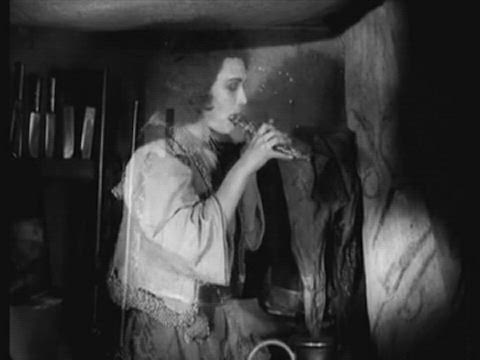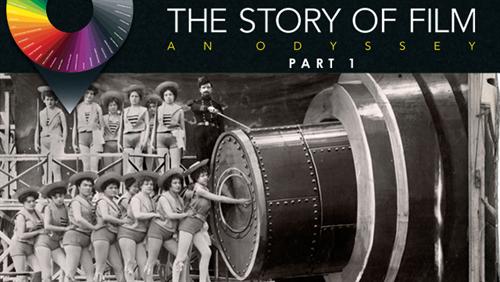For anyone trying to understand cinema as a visual storytelling medium from a global perspective, Mark Cousins’s 15-episodes documentary, ‘The Story of Film: An Odyssey‘, promises an enthralling ride. The documentary is an adaptation of a book Cousins wrote in 2004 and is produced by John Arche. It is an odyssey manoeuvring the cinematic history of Silent cinema, French impressionism, German expressionism, Italian Neorealism, Film Noir and French New Wave.
For anyone trying to understand cinema as a visual storytelling medium from a global perspective, Mark Cousins’s 15-episode documentary, The story of cinema: An odyssey, promises an enthralling ride. The documentary is an adaptation of a book Cousins wrote in 2004 and is produced by John Arche. It is an odyssey manoeuvring the cinematic history of Silent cinema, French impressionism, German expressionism, Italian Neorealism, Film Noir and French New Wave.
The documentary meticulously documents filmmakers of their time across the globe (America, Brazil, Britain, Denis, India, Iran, China, Czech, Japan, Korea, Poland, Scotland, Senegal, Swedish) and how their cinematic languages strengthened the visual storytelling medium. Cousins also dwells deeply on the state of art filmmakers, celluloid and the emergence of digital cinema, directors vs state censorship across countries, rebel directors, and popular entertainment yet innovative cinema of Hong Kong; China, Mumbai; India and California; America.
Cousins emphasises that it is high time to re-draw the map of film history that has been in our heads, the history that is factually inaccurate and racist by omission. And as Jean-Luc Godard puts “history of cinema is the history of men photographing women”. In this regard, the article focuses on three parts; the contribution of women writers and filmmakers, movements in films across the globe, and the emergence of African/African-American cinema.
Contribution of women writers and filmmakers
Hollywood was built by women, immigrants and Jews, revealed a film historian Cari Beauchamp in an interview with Cousins. Women wrote half of the films produced before 1925. Beauchamp reiterates, “Alice was not only one of the first female directors, but she was also one of the first directors…. Alice created dramatic arc film for the first time in Falling Leaves (1912).” Lois Weber, an innovative director and actress, shot sideway POV, split screens and vehicle mirror shots in suspense (1913) which were unconventional sequences of its time.
Cousins emphasises that it is high time to re-draw the map of film history that has been in our heads, the history that is factually inaccurate and racist by omission. And as Jean-Luc Godard puts “history of cinema is the history of men photographing women”. In this regard, the article focuses on three parts; the contribution of women writers and filmmakers, movements in films across the globe, and the emergence of African/African-American cinema.
Ironically, DW Griffith was credited as a director for many years. Frances Marion was the highest paying Screenwriter from 1915 to 1935. She is also the only woman at the time to win two Oscars for writing films; The Big House (1930) and The Champ (1931). Adela Rogers St. Johns, Bess Meredyth and Anita Loos wrote every conceivable genre of film. They were the ones that producers Irving Thalberg and Louis Burt Mayer (Co-founder of MGM studio) used to rely on for the big production films.

Věra Chytilová, an avant-garde director, widely recognised for the Czech New Wave film Daisies (1966), was banned by an authority in the country for ‘depicting the wanton’. Margarethe von Trotta was a prominent figure in New German Cinema, and her films featured the strong female protagonists usually set against the important political background.

Cousins regarded Kira Muratova, a Soviet-Ukrainian filmmaker, as the most underrated female director in cinema history. New Zealand director Jane Campion emphasised the timeless themes in her films. Piano (1993) won her the Palme d’Or at the Cannes Film Festival, making her the first female director to win the award. Cousin seemed to miss Ezuhan Palcy, a woman director from Martinique, French West Indies. She is the first woman of colour to direct a studio film (A Dry White Season, 1989) in Hollywood. Her films explored the theme of gender, race, and the effects of colonialism.
Cousins’ oeuvre in this documentary chronicled the cinema up to 2000. This documentary interestingly captures major breaking points in cinematic history from a global perspective. It would be an enlightening journey for those interested in understanding cinema as a visual storytelling medium. Moreover, His recent documentary The Story of Film: A New Generation (2021) covers the new generation of filmmakers.
Julie Dash is popularly known for the LA rebellion, the first African American who studied at UCLA. Kathleen Collins was an African-American woman who directed feature narratives — The Cruz Brothers and Miss Malloy (1980) and Losing Ground (1982).
Movements in films across the globe
In France, influence by the impressionist painters Germaine Dulac, Abel Gance and Marcel L’Herbier devised techniques such as non-linear editing, innovative lighting, attempts to portray dream sequences and fantasies, and other ingenious methods to tell a story. Abel Gance’s Napoléon (1927) is a masterpiece of French impressionism. In Germany’s 1910s and 20s, expressionist filmmakers used visual distortion and hyper-expressive performance to show the inner turmoil, uneasiness and fear of that era. Robert Wiene’s The Cabinet of Dr Kaligari (1920) and Fritz Lang’s Metropolis (1927) has a strong expressionist tone.
In the 1940s new cinematic language emerged from Italy. A language that dealt with the trauma of war — neorealism. Roberti Rosselini made Rome Open City (1945), and Vittorio De-Sica directed Bicycle Thief (1948). These films were pathbreakers and broke many conventions of filmmaking; handheld camera movement, use of long lenses and de-dramatisation. In America, John Ford directed Stagecoach (1939), creating a new visual fashion of deep space and deep focus in the cinema of the 1940s. With Billy Wilder’s direction of Double Indemnity (1946), emerged a film noir, a dark cinema in Hollywood.
Meanwhile, in the late 50s and early 60s ramifications of war reflected in life in Europe, and filmmakers had to consider the agonising experience in film. Four legendary filmmakers led the way in making movies more personal; Ingmar Bergman, Robert Bresson, Jacques Tati and Federico Fellini. Agnes Varda, Francois Truffaut, Jean Luc Godard and Alain Resnais of French New Wave broadened the horizon of cinematic language. French New Wave swept across the world — Poland, Hungary, Czechoslovakia, Japan, India, Brazil, Iran, Spain and Sweden. Cinema from these countries is drawn heavily from the new wave.
Post-70s directors from America, Japan, Iran, Sweden and Russia conceived their distinctive cinematic language that is worth mentioning here. The cinema of Mike Nicholas, Milo Forman and Robert Altman was satirical. Charles Burnett, Martin Scorsese, Dennis Hopper and Francis Ford Coppola challenged the conventional style of filmmaking, and Robert Towne and Peter Bogdanovich reworked with old studio genre with new techniques.

Joel and Ethan Coen and Hus Van Sant were American Postmodernists of the 90s. Mulholland Drive (2001) by David Lynch and Requiem for a Dream (2000) by Darren Aronofsky combined reality and fantasy in a new way.
In the 90s, Samira Malkhmalbaf and Abbas Kiarostami were geniuses in Iranian film history. Similarly, Wong Kar-wai Days of Being Wild (1990) and In the Mood of Love (2000) were films that have created striking persona in the cinematic universe. New Korean cinema emerged with Oasis (2002) by Lee Chang-dong, Memories of Murder (2003) by Bong Joon Ho, and Old Boy (2003) by Park Chan Woo. In Sweden, Roy Anderson’s film distinctly combined reality and dream in songs in Second Floor (2000). Alexander Sokurov directed Russian Ark (2002), the first single-take film.
The emergence of African and African-American cinema
Ousmane Sembène, a Senegalese filmmaker, often referred to as the father of African cinema, directed Xala (1975) about the transition from colonial to post-colonial identity. His antithetical ideas for Africa to undergo the radical enlightenment planted the seed for African Cinema — Third Cinema. South American directors Fernando Solanas and Octavia Getino issued a manifesto called Towards a Third Cinema and angrily criticised cinema for always being used as a commodity instead of a collective medium to fight poverty and oppression.
African Modernism has mushroomed through Djibril Diop Mambéty’s early films; Badou Boy (1970). Safi Faye is the first African woman to direct docufiction; Peasant Letter (1974). Haile Gerima, an Ethiopian director, directed Harvest: 3000 Years (1975). The story stretched over three millennia of a struggle between landlords and farmers. Wend Kunni (1983) by Gaston Kabore has three layers of flashback sequences, innovative for its time.
In America, nearly 60s years later, Gordon Parks and Charles Burnett got to direct feature films. UCLA played an ambiguous role in the emergence of African-American cinema. Charles Burnett reiterated that only American and European cinema had its screening.
The scenario changed after Elyseo Taylor, the first African American, was instated as a professor at UCLA Film Dept. He was radical and outspoken and introduced third-world cinema to UCLA. Charles Burnett directed Killer of Sheep (1978), which was about the School System that killed many kids and was created from a kid’s point of view. Gordon Parks’s Shaft (1971) was a cultural phenomenon of his time.
Also read: 8 Series For The Feminist In You To Binge-Watch
Cousins’ oeuvre in this documentary chronicled the cinema up to 2000. This documentary interestingly captures major breaking points in cinematic history from a global perspective. It would be an enlightening journey for those interested in understanding cinema as a visual storytelling medium. Moreover, His recent documentary The Story of Film: A New Generation (2021) covers the new generation of filmmakers.
Also read: WCC, Hema Commission And The Fight To Address Systemic Abuse In The Malayalam Film Industry
The Author is a writer and researcher. You can reach the author for comment and/or clarification at murabiyadivyesh@gmail.com.
Featured image source: DeviantArt, Walker Art Centre
About the author(s)
Divyesh Murabia is a writer and researcher. You can reach the author for comment and/or clarification at murabiyadivyesh@gmail.com.




